Clustering Multivariate Time Series
Clustering multivariate time-series is the process of grouping similar time-series data with more than one timestamped variable based on their patterns and characteristics.
Papers and Code
Radon-Nikodým Derivative: Re-imagining Anomaly Detection from a Measure Theoretic Perspective
Feb 25, 2025Which principle underpins the design of an effective anomaly detection loss function? The answer lies in the concept of \rnthm{} theorem, a fundamental concept in measure theory. The key insight is -- Multiplying the vanilla loss function with the \rnthm{} derivative improves the performance across the board. We refer to this as RN-Loss. This is established using PAC learnability of anomaly detection. We further show that the \rnthm{} derivative offers important insights into unsupervised clustering based anomaly detections as well. We evaluate our algorithm on 96 datasets, including univariate and multivariate data from diverse domains, including healthcare, cybersecurity, and finance. We show that RN-Derivative algorithms outperform state-of-the-art methods on 68\% of Multivariate datasets (based on F-1 scores) and also achieves peak F1-scores on 72\% of time series (Univariate) datasets.
Spatiotemporal Forecasting in Climate Data Using EOFs and Machine Learning Models: A Case Study in Chile
Feb 21, 2025Effective resource management and environmental planning in regions with high climatic variability, such as Chile, demand advanced predictive tools. This study addresses this challenge by employing an innovative and computationally efficient hybrid methodology that integrates machine learning (ML) methods for time series forecasting with established statistical techniques. The spatiotemporal data undergo decomposition using time-dependent Empirical Orthogonal Functions (EOFs), denoted as \(\phi_{k}(t)\), and their corresponding spatial coefficients, \(\alpha_{k}(s)\), to reduce dimensionality. Wavelet analysis provides high-resolution time and frequency information from the \(\phi_{k}(t)\) functions, while neural networks forecast these functions within a medium-range horizon \(h\). By utilizing various ML models, particularly a Wavelet - ANN hybrid model, we forecast \(\phi_{k}(t+h)\) up to a time horizon \(h\), and subsequently reconstruct the spatiotemporal data using these extended EOFs. This methodology is applied to a grid of climate data covering the territory of Chile. It transitions from a high-dimensional multivariate spatiotemporal data forecasting problem to a low-dimensional univariate forecasting problem. Additionally, cluster analysis with Dynamic Time Warping for defining similarities between rainfall time series, along with spatial coherence and predictability assessments, has been instrumental in identifying geographic areas where model performance is enhanced. This approach also elucidates the reasons behind poor forecast performance in regions or clusters with low spatial coherence and predictability. By utilizing cluster medoids, the forecasting process becomes more practical and efficient. This compound approach significantly reduces computational complexity while generating forecasts of reasonable accuracy and utility.
A Multi-Task Learning Approach to Linear Multivariate Forecasting
Feb 05, 2025



Accurate forecasting of multivariate time series data is important in many engineering and scientific applications. Recent state-of-the-art works ignore the inter-relations between variates, using their model on each variate independently. This raises several research questions related to proper modeling of multivariate data. In this work, we propose to view multivariate forecasting as a multi-task learning problem, facilitating the analysis of forecasting by considering the angle between task gradients and their balance. To do so, we analyze linear models to characterize the behavior of tasks. Our analysis suggests that tasks can be defined by grouping similar variates together, which we achieve via a simple clustering that depends on correlation-based similarities. Moreover, to balance tasks, we scale gradients with respect to their prediction error. Then, each task is solved with a linear model within our MTLinear framework. We evaluate our approach on challenging benchmarks in comparison to strong baselines, and we show it obtains on-par or better results on multivariate forecasting problems. The implementation is available at: https://github.com/azencot-group/MTLinear
Anomalous Agreement: How to find the Ideal Number of Anomaly Classes in Correlated, Multivariate Time Series Data
Jan 13, 2025Detecting and classifying abnormal system states is critical for condition monitoring, but supervised methods often fall short due to the rarity of anomalies and the lack of labeled data. Therefore, clustering is often used to group similar abnormal behavior. However, evaluating cluster quality without ground truth is challenging, as existing measures such as the Silhouette Score (SSC) only evaluate the cohesion and separation of clusters and ignore possible prior knowledge about the data. To address this challenge, we introduce the Synchronized Anomaly Agreement Index (SAAI), which exploits the synchronicity of anomalies across multivariate time series to assess cluster quality. We demonstrate the effectiveness of SAAI by showing that maximizing SAAI improves accuracy on the task of finding the true number of anomaly classes K in correlated time series by 0.23 compared to SSC and by 0.32 compared to X-Means. We also show that clusters obtained by maximizing SAAI are easier to interpret compared to SSC.
Multivariate Time Series Clustering for Environmental State Characterization of Ground-Based Gravitational-Wave Detectors
Dec 13, 2024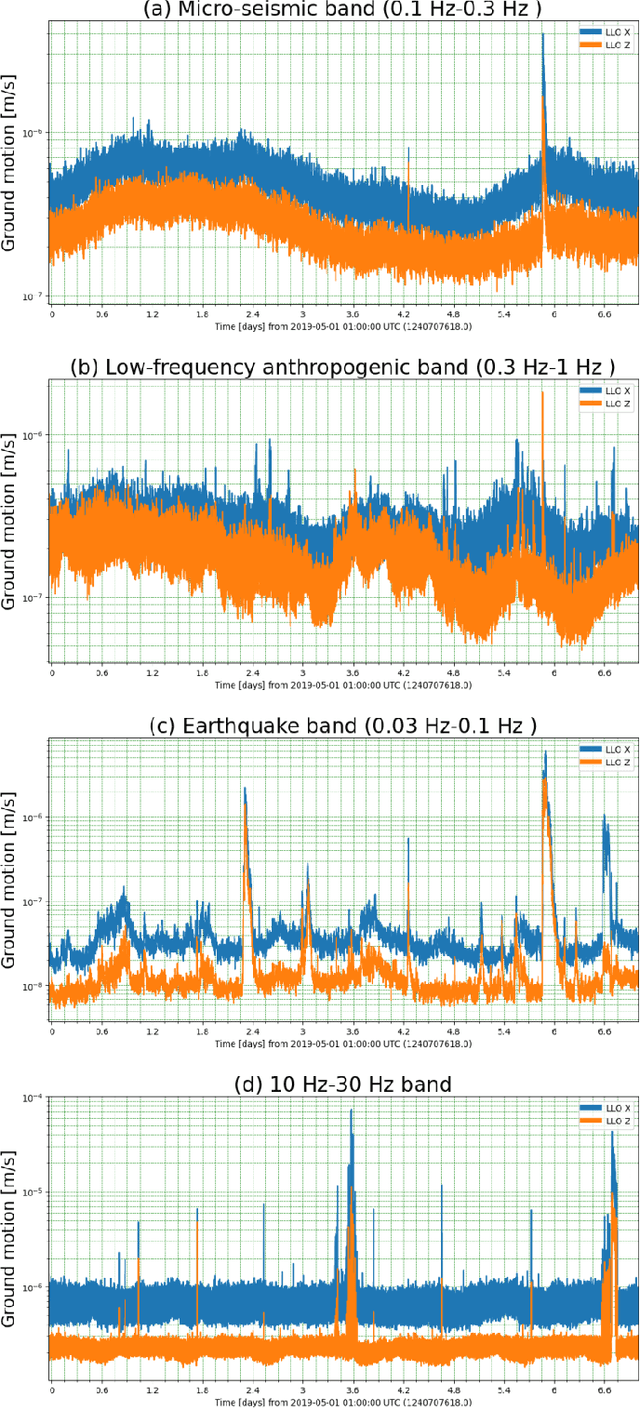
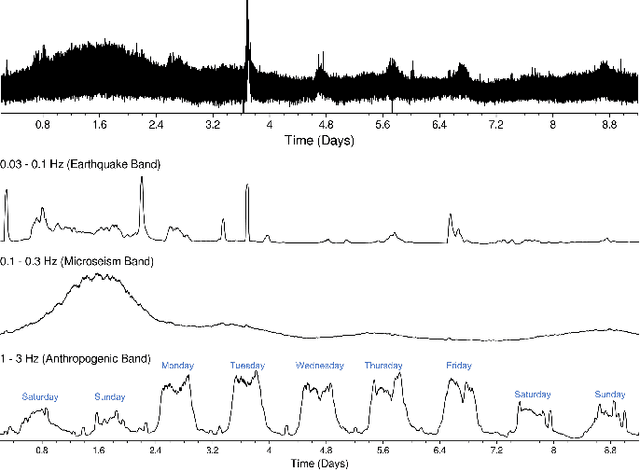
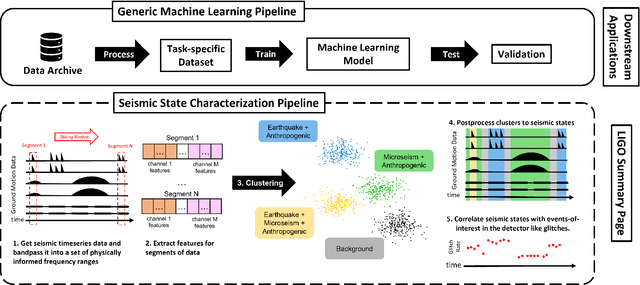
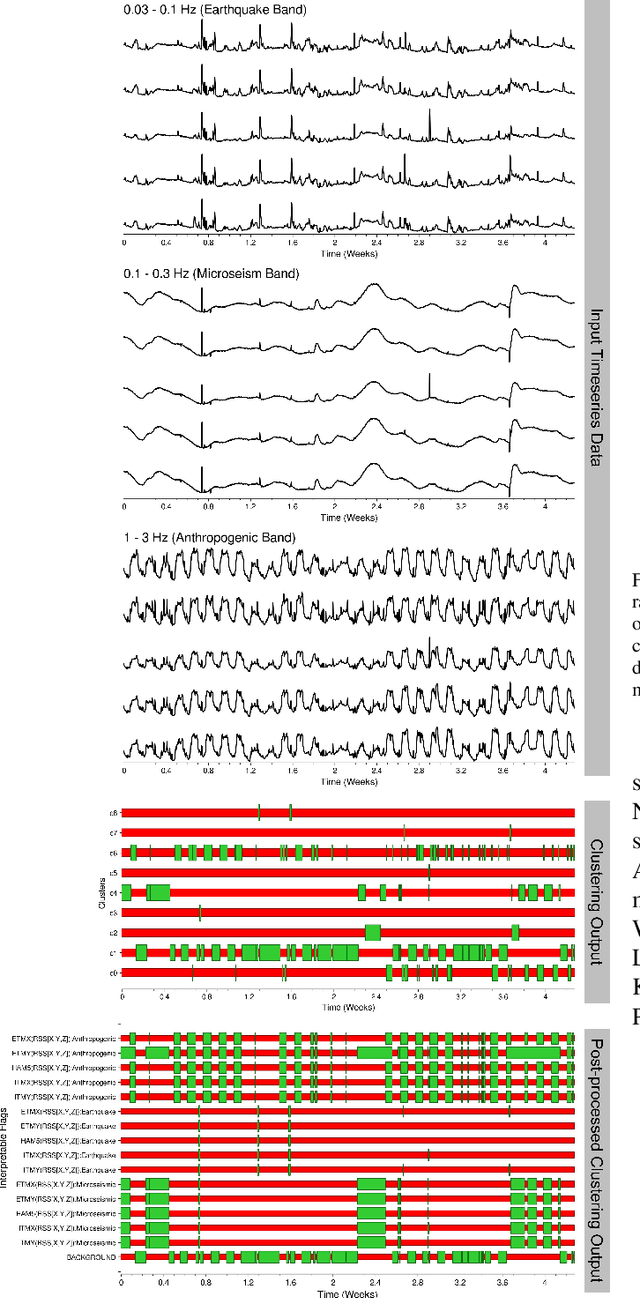
Gravitational-wave observatories like LIGO are large-scale, terrestrial instruments housed in infrastructure that spans a multi-kilometer geographic area and which must be actively controlled to maintain operational stability for long observation periods. Despite exquisite seismic isolation, they remain susceptible to seismic noise and other terrestrial disturbances that can couple undesirable vibrations into the instrumental infrastructure, potentially leading to control instabilities or noise artifacts in the detector output. It is, therefore, critical to characterize the seismic state of these observatories to identify a set of temporal patterns that can inform the detector operators in day-to-day monitoring and diagnostics. On a day-to-day basis, the operators monitor several seismically relevant data streams to diagnose operational instabilities and sources of noise using some simple empirically-determined thresholds. It can be untenable for a human operator to monitor multiple data streams in this manual fashion and thus a distillation of these data-streams into a more human-friendly format is sought. In this paper, we present an end-to-end machine learning pipeline for features-based multivariate time series clustering to achieve this goal and to provide actionable insights to the detector operators by correlating found clusters with events of interest in the detector.
DUET: Dual Clustering Enhanced Multivariate Time Series Forecasting
Dec 14, 2024
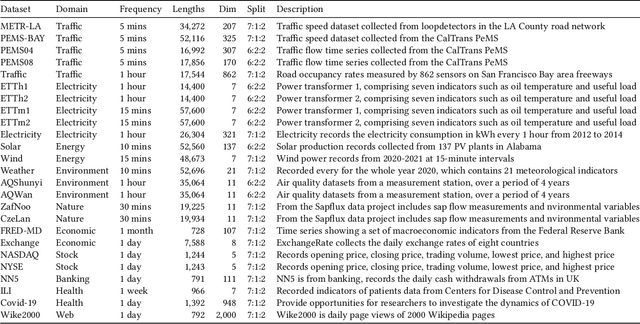


Multivariate time series forecasting is crucial for various applications, such as financial investment, energy management, weather forecasting, and traffic optimization. However, accurate forecasting is challenging due to two main factors. First, real-world time series often show heterogeneous temporal patterns caused by distribution shifts over time. Second, correlations among channels are complex and intertwined, making it hard to model the interactions among channels precisely and flexibly. In this study, we address these challenges by proposing a general framework called \textbf{DUET}, which introduces \underline{DU}al clustering on the temporal and channel dimensions to \underline{E}nhance multivariate \underline{T}ime series forecasting. First, we design a Temporal Clustering Module (TCM) that clusters time series into fine-grained distributions to handle heterogeneous temporal patterns. For different distribution clusters, we design various pattern extractors to capture their intrinsic temporal patterns, thus modeling the heterogeneity. Second, we introduce a novel Channel-Soft-Clustering strategy and design a Channel Clustering Module (CCM), which captures the relationships among channels in the frequency domain through metric learning and applies sparsification to mitigate the adverse effects of noisy channels. Finally, DUET combines TCM and CCM to incorporate both the temporal and channel dimensions. Extensive experiments on 25 real-world datasets from 10 application domains, demonstrate the state-of-the-art performance of DUET.
A Short-Term Predict-Then-Cluster Framework for Meal Delivery Services
Jan 11, 2025Micro-delivery services offer promising solutions for on-demand city logistics, but their success relies on efficient real-time delivery operations and fleet management. On-demand meal delivery platforms seek to optimize real-time operations based on anticipatory insights into citywide demand distributions. To address these needs, this study proposes a short-term predict-then-cluster framework for on-demand meal delivery services. The framework utilizes ensemble-learning methods for point and distributional forecasting with multivariate features, including lagged-dependent inputs to capture demand dynamics. We introduce Constrained K-Means Clustering (CKMC) and Contiguity Constrained Hierarchical Clustering with Iterative Constraint Enforcement (CCHC-ICE) to generate dynamic clusters based on predicted demand and geographical proximity, tailored to user-defined operational constraints. Evaluations of European and Taiwanese case studies demonstrate that the proposed methods outperform traditional time series approaches in both accuracy and computational efficiency. Clustering results demonstrate that the incorporation of distributional predictions effectively addresses demand uncertainties, improving the quality of operational insights. Additionally, a simulation study demonstrates the practical value of short-term demand predictions for proactive strategies, such as idle fleet rebalancing, significantly enhancing delivery efficiency. By addressing demand uncertainties and operational constraints, our predict-then-cluster framework provides actionable insights for optimizing real-time operations. The approach is adaptable to other on-demand platform-based city logistics and passenger mobility services, promoting sustainable and efficient urban operations.
A Survey on Time-Series Distance Measures
Dec 29, 2024Distance measures have been recognized as one of the fundamental building blocks in time-series analysis tasks, e.g., querying, indexing, classification, clustering, anomaly detection, and similarity search. The vast proliferation of time-series data across a wide range of fields has increased the relevance of evaluating the effectiveness and efficiency of these distance measures. To provide a comprehensive view of this field, this work considers over 100 state-of-the-art distance measures, classified into 7 categories: lock-step measures, sliding measures, elastic measures, kernel measures, feature-based measures, model-based measures, and embedding measures. Beyond providing comprehensive mathematical frameworks, this work also delves into the distinctions and applications across these categories for both univariate and multivariate cases. By providing comprehensive collections and insights, this study paves the way for the future development of innovative time-series distance measures.
TDGCN-Based Mobile Multiuser Physical-Layer Authentication for EI-Enabled IIoT
Nov 13, 2024



Physical-Layer Authentication (PLA) offers endogenous security, lightweight implementation, and high reliability, making it a promising complement to upper-layer security methods in Edge Intelligence (EI)-empowered Industrial Internet of Things (IIoT). However, state-of-the-art Channel State Information (CSI)-based PLA schemes face challenges in recognizing mobile multi-users due to the limited reliability of CSI fingerprints in low Signal-to-Noise Ratio (SNR) environments and the constantly shifting CSI distributions with user movements. To address these issues, we propose a Temporal Dynamic Graph Convolutional Network (TDGCN)-based PLA scheme. This scheme harnesses Intelligent Reflecting Surfaces (IRSs) to refine CSI fingerprint precision and employs Graph Neural Networks (GNNs) to capture the spatio-temporal dynamics induced by user movements and IRS deployments. Specifically, we partition hierarchical CSI fingerprints into multivariate time series and utilize dynamic GNNs to capture their associations. Additionally, Temporal Convolutional Networks (TCNs) handle temporal dependencies within each CSI fingerprint dimension. Dynamic Graph Isomorphism Networks (GINs) and cascade node clustering pooling further enable efficient information aggregation and reduced computational complexity. Simulations demonstrate the proposed scheme's superior authentication accuracy compared to seven baseline schemes.
Accelerated Sub-Image Search For Variable-Size Patches Identification Based On Virtual Time Series Transformation And Segmentation
Oct 20, 2024This paper addresses two tasks: (i) fixed-size objects such as hay bales are to be identified in an aerial image for a given reference image of the object, and (ii) variable-size patches such as areas on fields requiring spot spraying or other handling are to be identified in an image for a given small-scale reference image. Both tasks are related. The second differs in that identified sub-images similar to the reference image are further clustered before patches contours are determined by solving a traveling salesman problem. Both tasks are complex in that the exact number of similar sub-images is not known a priori. The main discussion of this paper is presentation of an acceleration mechanism for sub-image search that is based on a transformation of an image to multivariate time series along the RGB-channels and subsequent segmentation to reduce the 2D search space in the image. Two variations of the acceleration mechanism are compared to exhaustive search on diverse synthetic and real-world images. Quantitatively, proposed method results in solve time reductions of up to 2 orders of magnitude, while qualitatively delivering comparative visual results. Proposed method is neural network-free and does not use any image pre-processing.
 Add to Chrome
Add to Chrome Add to Firefox
Add to Firefox Add to Edge
Add to Edge